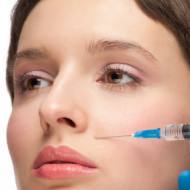AESTHETICS OF THE FACE AND AREAS AROUND THE MOUTH
When a complete or complex prosthetic rehabilitation is performed, restoring the aesthetics of the smile, it is definitely important and necessary to consider the entire face, the tissues that form it and their aging. Not taking these into consideration may result in only partial success, failing at the end of our treatment to harmonize our work with the entire face. Over the years, our face undergoes significant changes that affect not only the skin but also the deeper structures. The skin of the face may have a reduced subcutaneous adipose tissue accompanied by changes of the mimetic muscles, while the underlying structures (the skeleton bone and cartilage) may undergo resorption or remodelling.
Due to the involvement of all structures, it is important to perform a three-dimensional evaluation of the face before applying any type of treatment.
The analysis of the face is made entirely by examining the shape of the face and the biological correspondence with the age of the patient, collecting as much information as possible relating to the proportions and symmetry. A careful visual examination helps us to understand what areas of the face catch our attention more, trying to understand even the reason behind it.
The profile provides information on facial height, especially in relation to the size of the lower third of the face. A variation of the latter alters the harmony and thus the perception of the face.
The examination of the oral region is carried out by evaluating the shape, size, volume, tone and symmetry of the upper lip with the lower lip, also considering the vermilion, also called cupid’s arch, and the existence of skin imperfections such as wrinkles on the upper edge of the lip and nasolabial folds.
The importance of the restoration of the volume of deep structures in the treatment of wrinkles is now widely recognized in international literature. Many materials have been used in the past to increase the volume of the soft tissues of the face and for the treatment of superficial wrinkles, obtaining different results over time. The search for the “perfect product” has always had the objective to find a biocompatible, long-lasting material, which is natural in the result and to the touch, easily injected and without complications. The safest materials are those based on natural hyaluronic acid, but unfortunately the procedures have to be repeated over time.
Hyaluronic acid is a disaccharide present in all human connective tissues, including in the dermis. Its function is to confer the right elasticity and hydration to the tissues, acting as a liquid retention element. Each of us has about 15 gr. of hyaluronic acid present in the body, a third of which is physiologically replaced every day. This substance is essential for the formation of the matrix and elastic fibers. The introduction of hyaluronic acid in the dermis surface allows to produce a substance (produced in small quantities by the body, in the period of cellular aging), capable of stimulating the neo-synthesis of collagen, elastin and endogenous hyaluronic acid, favouring the reorganization of the extracellular matrix.
If you are using hyaluronic acid in its cross-linked form and therefore heavier (so-called filler), we get that filling effect and the obvious restoration of volumes, that sometimes is unnatural and not very aesthetic. The implanted material acts as a volumizer without exerting any stimulation at biological level. The result shall start to decline after about 3-4 months and after about 6 months a new treatment shall be required.
If you are using instead the hyaluronic acid in its pure form, a bio-revitalization effect is obtained: in practice, the inserted material draws liquid and stimulates the production of new endogenous hyaluronic acid, restoring the hyaluronic acid that was physiologically lost with aging, with exposure to ultraviolet light, smoke and air pollution. The initial effect is less dramatic and obvious than using a filler and the treatment should be repeated after about three months. The goal of these treatments is to make the facial volumes more harmonious, reshape the asymmetries, smooth out any expression lines, remove blemishes of the soft tissue, and prevent damage from aging.

